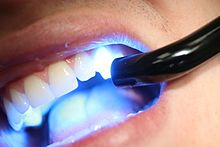Light curing
By means of light-curing are in the dentistry and dental technology plastics cured. The hardening process takes place through a chain polymerization . Composites are used as plastics . The name indicates that it is a mixed polymer in order to obtain the desired properties. In dentistry, composites are used in filling therapy . In dental technology, veneers (sheathing) or individual plastic spoons are light-cured , among other things . The desired workpiece can be shaped or modeled from plastic material. As soon as the desired shape has been achieved, the plastic material is irreversibly cured with a polymerization lamp by means of light curing.
principle
The advantages of light curing compared to chemical curing are the higher degree of polymerization , the precise determination of the start of polymerization and the rapid, complete polymerization. The disadvantage is that the light has only a limited possibility of penetrating the composite and there is a risk that, if the layers are too thick, parts will not be completely cured in depth.
The light curing is carried out by photons , which form free radicals in certain proportions , which set the polymerisation process in motion. The photons involved must have a wavelength that hits the photoinitiators . In dentistry, initiators are used for which the optimal wavelength of the curing light is 400–500 nm (blue light). Halogen light was the standard for a long time ; it covers a wide spectrum of light , a filter removes the longer and shorter wavelengths. Therefore only a part of the generated photons are available for the photo-activation process. In addition, were plasma arc lamps , laser - and LED lamps developed. The plasma arc light is generated by electrodes between which sparks of high light intensity are generated. For a few years now, LED lights have been the most widely used. They contain LED lamps, which consist of a single coated semiconductor - pn connection (p = positive, n = negative charge), which are connected to a direct continuous ( DC ) voltage source . If you choose the right pn connection material, the color of the LED can be checked.
Chemical process
A polymerization can proceed radically, ionically or coordinatively; In dentistry / dental technology, the radical method is usually chosen, a chemical reaction in which free radicals of the monomers seek another free radical in order to combine. The polymerisation of composites takes place in three stages:
- Start reaction (initiation) in which the active center is formed.
- Growth reaction (propagation) in which the macromolecular chain grows in a chain reaction (repeated addition of the monomers )
- Termination reaction in which the growth of the chain is irreversibly terminated by disproportionation reactions or combinations.
In order to get the polymerization going, initiators are added to the composite , which ensure the formation of the necessary radicals . These are diketones such as camphorquinone or benzoin alkyl ethers . The diketone is stimulated by blue light and reacts with a "reducing agent". A complex is created that breaks down into radicals and thus initiates the reaction. This then binds to a monomer molecule by opening the double bond and transferring the released electron to the end of the newly formed chain. The open end of the monomer molecule can form a stable bond with a similar one by in turn transferring an electron. Long chains of monomer molecules form within a short time and form chemically and physically stable polymers .
State of research
The subject of light curing has long been a controversial issue. In order to reach an agreement and speak with one voice, around 40 experts from science and research from around the world met in 2014 for a symposium on light curing in dentistry at Dalhousie University in Halifax , Canada . The aim was to give the practitioner a guideline to reliably implement light curing in everyday practice.
recommendations
Care should be taken with curing lights with very high light output (1500 to 2000 mW / cm²) and recommending very short light curing times (1–5 s). Particularly with short light curing times, it is important to ensure that the end of the light guide is fixed during the curing process. Every composite material requires a certain amount of energy at a certain wavelength for satisfactory curing; it is calculated from the light output × light curing time, whereby the minimum curing times must be observed. The light output of the curing light should be checked regularly. The light curing times are to be extended with large distances, with dark or opaque colors. Teeth should be cooled with an air blower with long light curing times or polymerization lamps with high light output.
Precautions
Polymerization light should not be aimed directly at the eyes. If necessary, use suitable (orange) eye protection.
History of light curing
In 1972 the first UV-light-curing composite was brought onto the market ( Nuva-Fil from LD Caulk ( Dentsply International )). This was followed in 1978 by the first composite that was cured by light curing with visible blue light ( photo film by Johnson & Johnson ).
literature
- The efficient use of light polymerization devices - a guide for dentists , ZMK, vol. 30, edition April 2014, pp. 166–179. Retrieved January 22, 2016.
Web links
Individual evidence
- ↑ Lothar Pröbster: Innovative procedures in dentistry: Modern treatment concepts for the practice . Springer-Verlag, July 29, 2013, ISBN 978-3-662-07906-5 , pp. 27 ff.
- ↑ a b Iris Burkard, light curing in the plastic veneering technique , ZWP, August 31, 2009. Accessed on January 22, 2016.
- ^ Josef Schmidseder: Aesthetic dentistry . Georg Thieme Verlag, December 17, 2008, ISBN 978-3-13-158792-3 , p. 93.
- ↑ a b c Light Curing - A Guide for Practitioners , Zahnärztliche Mitteilungen , March 1, 2015. Accessed January 22, 2016.
- ↑ FDA 510 (k) Application Details - K772278 . Retrieved January 22, 2016.

